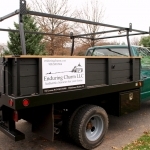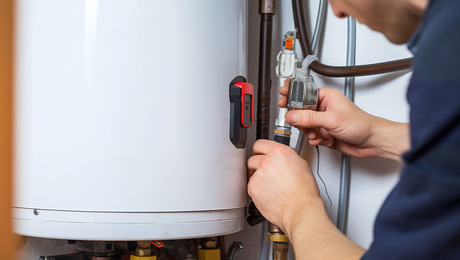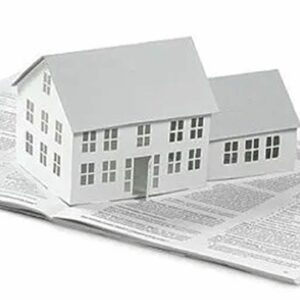Hi all:
I’m a carpenter with enough electrical knowledge to be dangerous. I’m planning a stand alone barn located about 20 feet from my house and I need help with the electric. I’ll have five 15A lighting circuits and five 20A general circuits and I was thinking of a 150A panel to allow for expansion. The part I need help with is getting power to the barn panel.
The service meter is located on my garage, with a two foot loop into a panel inside my garage. (see pic.) That panel has a single 240v 150 amp breaker which is tied to a 150a subpanel in my basement. What I would like to do is replace that garage main with a new box that has a breaker for each subpanel (house and barn).
What I don’t know is:
–will the service cable from the meter support two 150A breakers?
–Do they make a box with two 240v breakers to feed two subpanels?
–What cable size/type do I need to feed the barn panel?
–How do I best handle the buried cable between the barn and garage?
–What am I missing?
Any help or hints are welcomed…
John Painter




















Replies
"--will the service cable from the meter support two 150A breakers?"
Hard telling from the picture, but I doubt it.
If you are talking about having 2 150 amp breakers in parallel then you would need a 320 amp meter and service feed from the POCO.
But first why do you think that you need a 150 service to the barn. How much growth do you expect?
If you want you can use a 100 amp or even 150 or 200 amp panel in the barn so that it has enough slots for future breakers. The common 60 or 80 amp sub's don't have many slots.
But still feed it with a 60 amp feedeer cable and breaker.
Figure what you load is in the house.
http://www.taunton.com/finehomebuilding/pages/bh0019.asp
And then figure out the max load in the barn.
That is be based on the largest combination of equipment that you will want to run at ANYONE TIME. Or want to have in the future.
For a woodworkers that might be 3 hp table saw and 2hp dust collector plus some lights. And maybe an electric heater.
60 amps is more than enough for stuff like that.
Look at this thread for some more options.
http://forums.taunton.com/n/mb/message.asp?webtag=tp-breaktime&msg=87873.1
.
A-holes. Hey every group has to have one. And I have been elected to be the one. I should make that my tagline.
Bill:
That's good advice--I just arbitrarily picked a 150 amp panel for the barn, but I see what you mean about the breaker on the other side. I'll look harder at that, especially since I'd rather not have to pull the meter and all that.
J.
If this is a real barn, do some research about the peculiarities of wiring one. Some animals are extremely sensitive to stray electromagnetic fields, and the NEC mentions an 'equipotential plane'.
R;
The only animal in this barn will be me. I'm building it to house tools and materials for my contracting business.
John
--will the service cable from the meter support two 150A breakers?
Judging from the photo, no, it won't. The lines from the meter seem to be the same size as those running to the panel. Those running to the panel are probably sized correctly for 150 amps, which means the meter lines are too small for 300 amps.
--Do they make a box with two 240v breakers to feed two subpanels?
Well, Square-D makes one that will handle two 125 amp panels. Perhaps another manufacturer has a 150 amp.
--What cable size/type do I need to feed the barn panel?
IIRC, 2/0 is the correct size for 150 amps, but Bill has the right idea. You probably don't need 150 amps out there. Work out how much power you will be using at any one time and divide that by .8. That's roughly the size of the main breaker you need.
--How do I best handle the buried cable between the barn and garage?
Head down to the library and take a look at the National Electric Code. I think that buried in conduit will be the way to go, but I don't know how deep and I don't know if plastic conduit is acceptable; I suspect not. While you're reading the code book, look up the answer to your question about cable size.
George Patterson
George:
Thanks--I actually do have the codebooks, but, as I said, I'm a carpenter not an electrician! Clearly I need to rethink the 150A breaker, but I'm also thinking maybe I'd be smarter to hire an electrician to re-do the box at the meter. I'm comfortable enough doing the circuits and the panel in the barn, I've just not done the more significant work at the meter before.
I'm fighting costs on this project. At the moment my design for a 24x36 1.5 story barn with a 12x24 shed addition out the back is between $30-35K in materials. The labor is all mine and I work REALLY cheap for myself. Even though I'm in the business I guess I'm not immune to sticker shock.
Oh well, easy go...easy go, I always say. ;-)
John
You really need to hire an electrician for this job; there are enough design issues that you need his professional judgment.
The general approach will be to replace that disconnect with a panel. The panel will have it's own 'main' breaker that will kill everything, as well separate breakers for the panels in the house and the barn.
There are - no surprise here - some pretty important details in the grounding of the system. It is possible that the wires feeding the panel in the house will need to be replaced, and a fourth (ground_ wire added. The NEC has clarified the grounding rules quite a bit over the years, and very few multi-building places (like yours) comply with today's rules. Again, this is for the electrician to examine.
Now ... since there is a panel, and not a simple disconnect ... the old rule applies: One does NOT add up breakers! Rather, an electrician will perform a 'load calculation,' and determine just how much power you need. I know, it sounds strange, but it is quite possible for a 150 amp service to supply two 150 amp breakers.
As for getting power to the barn, again, my usual advice stands: run BIG pipe, and bury it DEEP. This will allow you to pull larger wires later, if you need them.
Your new building will need a 'ground electrode,' as well as a ground wire connecting the panels. The 'electrode' can be a ground rod, or any of several different methods. Local codes may require a particular method to be used with a new building.
Yeah, I've come to the conclusion that I'll need to find an electrician before I go submitting permits. I was aware of some of those grounding issues, and the need to separate the neutral from the ground on the sub panels.
I'll definitely run the biggest pipe I can in the ground for future needs. I'm also a believer in not doing things twice. I'm not a 100% sure of my needs in the barn because I may decide to put electric heat out there down the line and, even though I can only use one power tool at a time, I may have other people helping out in the future.
Thanks for the advice...
John